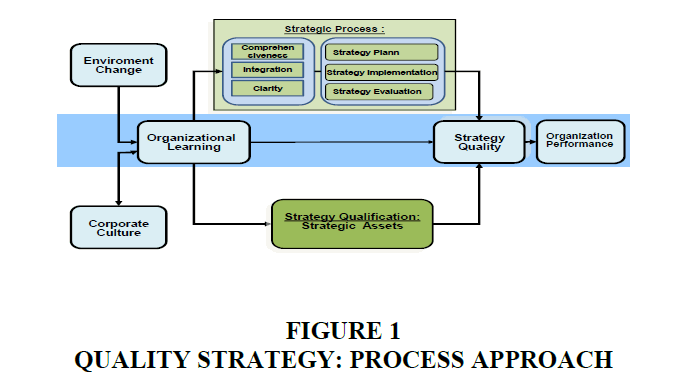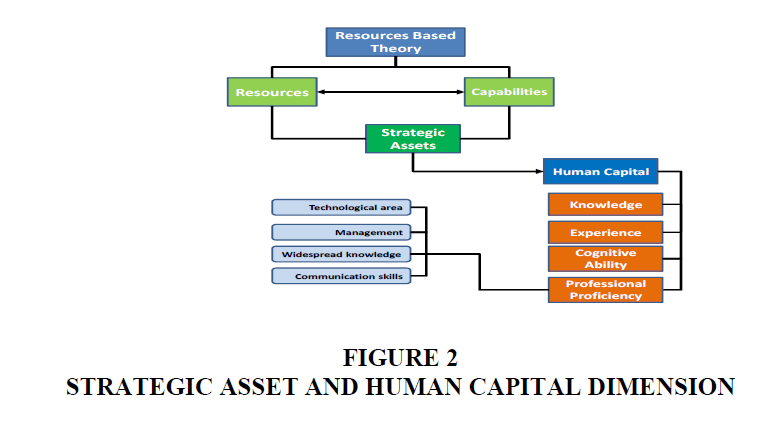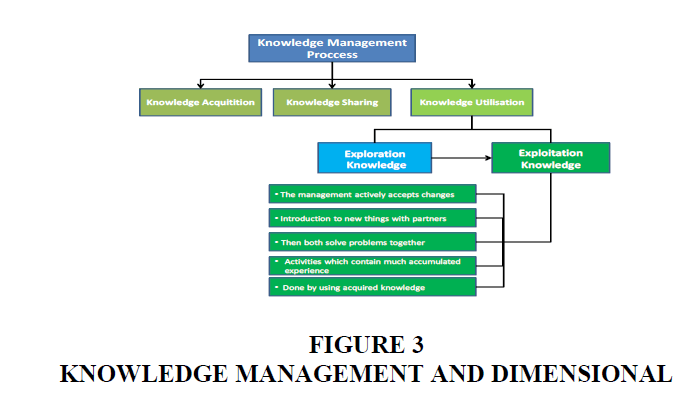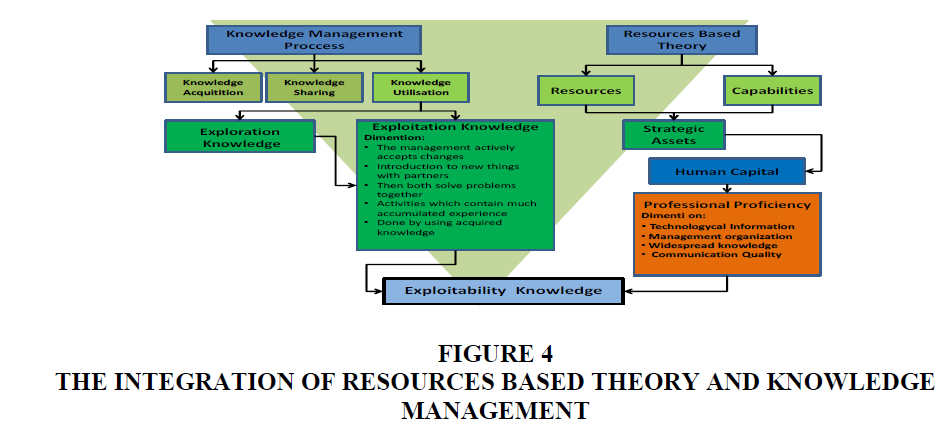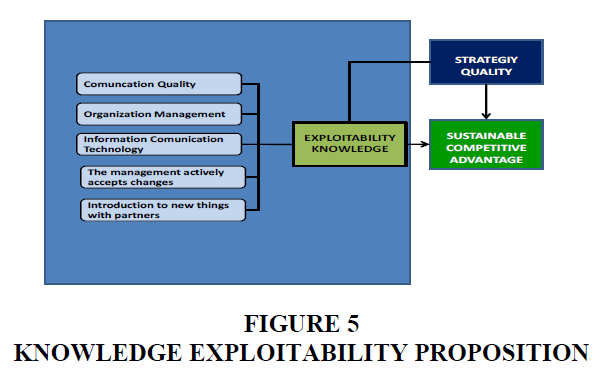Research Article: 2018 Vol: 17 Issue: 2
Grand Theory Model of Strategy Quality: Strategic Asset Approach at Industry
Widodo, UNISSULA
Kesi Widjajanti, University of Semarang
Keywords
Strategy Quality, Strategic Assets, Exploitability Knowledge, Sustainable Competitive Advantage, Human Capital, Content Strategy.
Introduction
The basic problem in the strategic management is on how an organization achieves a superior performance and preserves the sustainable competitive advantage (David, Pisano & Shuen, 1997). Sustainable competitive advantage appears as one of the most promising theoretical frameworks in the management literature, especially in the strategic management field (Low, 2010). Sustainable competitive advantage becomes very essential and substantial if the market is highly competitive. However, sustainable competitive advantage is not the final destination of various strategic manoeuvre developed by the organization, as it is only the main tool to achieve the bigger purposes such as the accomplishment and the safety warranty for the sustainability of the long-term performance achievement. Hence, the organization should focus on the strategic management.
However, not all organizations are success with their strategies, which mean that those organizations already have strategies but not many of them generate superior performance. Such condition relates with strategic quality. There are some approaches to realize strategic quality. The first approach is through strategic process which means that strategic quality is a strategy which is built through strategic formulation quality, strategic implementation quality and strategic evaluation quality (Menon, 1999). A good strategic development process should be started from a basic belief that the strategy should have appropriate strategic content, with high quality of formulation process as well as clarity and firmness of the implementation and evaluation that should be done (Varadarajan, 1999).
The second approach is through strategic asset. The strategic assets are resource and capability that have potential to generate competitive advantage. On the other hand, Amit & Schoemaker (1993) state that strategic assets are resource and capability which are scarce, uneasily traded, inimitable, durable and can be used to convert the value become profit. Those strategic assets can be categorized into larger groups, such as financial assets, physical assets, human assets, technological assets and intangible assets (Grant, 1991). Therefore, the threat faced by the leader should integrate the resource and capability into strategic assets in order to realize the sustainable competitive advantage.
The resource based view emphasizes on knowledge-based resource (Galunic & Rodan, 2008), as knowledge becomes an important component in the new economic arena (Grant, 1991). The emphasis on knowledge triggers the development of Knowledge Management (KM) concept, as the assumption then is that the knowledge resource is important in the production process. KM emphasizes on the organization ability to use and combine various knowledge resources which are able to change the intangible resource into innovation. The study conducted by Hsu (2007) shows that 80% of respondents agreed that knowledge is strategic asset, while 78% business opportunities failed because of inability to exploit the knowledge in the organization. Then, the study conducted by Leticia (2012) explains that knowledge is the most important resource in the competitive advantage, but the relationship between knowledge management and competitive advantage is weak.
Based on the above explanation, it can be concluded that managing an organization is like managing knowledge, as knowledge will not meaningful if it is only used as information. Conversely, knowledge will be meaningful if it is well-implemented. Thus, it acquires knowledge exploitability.
Strategic Quality
The studies conducted by Menon, Bharadwaj & Roy (1996) explain that the improvement of organizational performance is determined by the strategy used. Strategy is an overall plan which explains the competitive position of an organization. Strategy as a set of methods is used to enhance, produce and sell actual products and services. Organization strategy is a decision pattern dealing with important things used for: (1) Being guideline for the organization in facing the environment, (2) affecting the internal matters of the organization either the structure or the process and (3) affecting the organizational performance (Hambrick, 1980). While strategic quality is a strategy which is built by strategic planning quality, strategic implementation quality and strategic evaluation quality (Menon, Bharadwaj & Roy, 1996).
Based on the study conducted by Widodo, the conceptual model of strategic quality enhancement comprehensively appears in Figure 1. The environmental changes will lead into organizational culture and organizational learning changes. Organizational learning needs support and should be developed as organizational culture. Organizational learning will be able to recognize: 1) Strategic asset prerequisite which has potential to enhance the strategic quality, 2) strategic process which covers strategic planning aspect, strategic implementation and strategic evaluation. A high quality of strategy is reflected in the planning process quality, implementation process quality and evaluation process quality. The strategic quality will trigger an improvement on organizational performance.
One focus of the system management concern is on the process management. If strategic development can be considered as a process, then the high quality process should become a mutual concern in the management. It means that process management is expected to be able to serve a high quality process. Therefore, the strategy appears through the high quality process will generate a high quality strategy as well. Thus, strategic quality is the comprehensiveness and coherence level among the strategic planning process made by the clarity of strategic implementation process and strategic evaluation process which will be conducted.
Strategic Asset
Approaches in strategic management are differentiated into ‘what’ approach and ‘how’ approach (Hendrawan et al., 2003). Besides, according to Miller, strategic management approaches includes ‘content’ and ‘processes. One of the questions in the ‘process’ approach is how a strategy is compiled or stating ‘this is how you do it’. Besides, ‘content’ is what makes the organization succeed or stating ‘this is to be done’. Such condition will lead to strategic asset area.
Approaches in strategic management are differentiated into ‘what’ approach and ‘how’ approach (Hendrawan et al., 2003). Besides, according to Miller, strategic management approaches includes ‘content’ and ‘processes. One of the questions in the ‘process’ approach is how a strategy is compiled or stating ‘this is how you do it’. Besides, ‘content’ is what makes the organization succeed or stating ‘this is to be done’. Such condition will lead to strategic asset area.
The challenge faced by the leader has relation with strategic asset, which is needed to benefit the company. The main sources which have competitive advantage are strategic asset concept (Amit & Schoemaker, 1991). Therefore, the leader of organization should make decision on strategic asset enhancement attempts both in the present and in the future. Johnson (1999) explains competence term as strategic asset. Strategic asset has long-term specific and uncertainty characteristics, so the competence should be maintained. Competence (strategic asset) is resource and capability which becomes competitive advantage resource for the organization, more than other competitors (Hitt, Ireland & Dan Hoskinsson, 2001). Not all of the resources and capabilities have potential to be competitive advantage. Some of resources and capabilities may incompetent because they are weaker than their competitors. These strategic assets can be categorized into larger groups, such as financial asset, physical asset, technological asset, intangible asset and human capital asset (Grant, 1991).
Human capital is Human Resource (HR) characteristic determined by the organization which is used to create value for the organization (Hsu, 2007). Therefore, the HR capacity limits the other organization’s opportunity. A group of high motivated and skilled people is competitive advantage because it represents a specific resource of organization which is important, scarce and inimitable. A company with skilled and knowledgeable HR has higher human capital and is more possible to generate knowledge, make right decisions and has better innovation in technology (Hitt et al., 2001).
However, the problem faced by the company then is on how it can support the HR to contribute their knowledge for the profit of the company. The HR may be reluctant to share their knowledge because they are afraid of losing ownership, important position or superiority. Therefore, for the organization interest, the leader should emphasize on the development of capability and commitment (willingness and desire to contribute for the success of the organization). Thus, human capital should involve the HR competences, such as skill, knowledge, capability as well as commitment, for instance, the willingness to dedicate their life and work for the company (Hsu, 2007). The study conducted by Augusto & Eduardo (2014) show that human capital dimension includes: Knowledge quality, intensive experience, cognitive ability and professional ability. The professional ability indicator covers: Ability in technology area, communication quality, organizational management and widespread knowledge. The above explanation about strategic asset then is shown in Figure 2.
Knowledge Management
Knowledge management has strategic role and value added as it can stimulate the improvement of organizational effectiveness. Many organizations cannot function as knowledgebased organizations because of their inability in organizational learning process. According to Mohsen (2011), knowledge has been recognized as essential source to achieve sustainable competitive advantage and the core competence invention value. Knowledge becomes important component in the new economic arena (Grant, 1991).
The knowledge management concept aims to build better organization (Amrous, 2014). The existing literature defines knowledge management as integration and individual coordination as well as organizational management by managing the knowledge organization flow and generating new knowledge (Jyoti, 2011). Then, Leticia (2012) shows that knowledge management means managing the information flows and get the right information to the people who need it quickly. The study also states that knowledge is the most essential source in the competitive advantage, but the relationship between knowledge management and competitive advantage is weak. Although there has no universally acceptable definition about knowledge management, according to Shin (2004), process approaches is improving the knowledge management quality by identifying knowledge flow process and management. Knowledge management has become foundation in the organizational strategy. Post-industrial organization is knowledge-based and their success and survival depends on their creativity, innovation and findings. The studies of Jyoti (2011); Márcia (2012) show that knowledge management dimension includes: Knowledge sharing, knowledge creation, knowledge protection and knowledge utilization. Besides, according to Susanne & Ingi (2012), it includes knowledge identification, knowledge creation and knowledge storage/retention and knowledge transfer and knowledge utilization. Based on the studies of Sangjae, Byung & Hoyal (2011), the dimension covers acquisition, conversion, application and protection. Then, based on theoretical dynamics and phenomena in this study, it is summarized into knowledge acquisition, knowledge sharing and knowledge utilization.
Knowledge acquisition aims to give information about how often a company’s knowledge interacts with external environment. Then, knowledge sharing means interaction and communication among individuals and business units. According to Smalla & Sageb, the success of knowledge sharing depends on the interaction quantity and quality among employees as well as ability and willingness in using the knowledge. An organization should support its and the employees’ purposes, then interpret the purposes into technical and promote the employees. The knowledge existing within the individual is difficult to be verbalized, so it needs to be articulated and stated in implicit knowledge print. Based on the above explanation, it can be concluded that knowledge sharing is a behavior of individual to spread the knowledge to the other members within an organization in order to create value added for the company. Therefore, the role of every HR is to share the knowledge in order to increase the benefits, for the best human are those who benefit the other human being.
Knowledge utilization is used to change behaviors or develop new ideas (Márcia, 2012). Some factors which can influence people to use knowledge are the lack of trust in the knowledge sources, missing opportunities, fear of taking risks and too fast to consider knowledge as unimportant. Yi (2011) explains that knowledge utilization includes knowledge exploration and knowledge exploitation.
Exploitation basically is a process of acquiring competences by adopting, synthesizing and applying the existing knowledge. This acquires knowledge which has been generated and internalized to use and create reliability in experience. Exploitation refers to external knowledge implication to repair the existing products within an organization and increase its process. It can also be said that exploitation roles as the use or further as the development of the existing competences. The indicators of knowledge exploitation are: The management actively accepts changes, introduction to new things with partners, then both solve problems together, activities which contain much accumulated experience and are done by using acquired knowledge (Tom, 2007).
Based on the above explanation about knowledge management is presented in Figure 3:
Sustainable Competitive Advantage
In today’s competitive and dynamic business environment which has and acquires sustainable competitive advantage has become the basic goal or even philosophy for the organization (Low, 2010). Therefore, for the long term survival, only by ensure the average performance is not enough and becomes an acquired prerequisite for the organization to have sustainable competitive advantage.
Organization is believed to have obtained sustainable competitive advantage when it is able to create and implement strategies that are not implemented by other organization. Based on the in-depth literature review about the development of sustainable competitive advantage concepts, it can be concluded that in the 1990s, Sustainable Competitive Advantage (SCA) concepts from ‘resource-based view’ and ‘intangible resource’ became dominant theme. These concepts then were examined by the researchers in order to give detail identification, especially focusing on ‘intangible resource’ aspect as sustainable competitive advantage, for instance; branding, market orientation, organizational learning, innovation, customer value, marketing relationship and networks.
Then, in the 21st century, SCA indicators develop into organizational learning, knowledge management, management of information system, technology and innovation, globalization, etc. However, it does not reduce the importance of SCA as one of most essential issues in the strategic management. The literature reviews of strategic management in the 21st century are mainly focused on intangible resource as sustainable competitive advantage source.
Basic Theoretical Model
Based on the study of resources based theory as well as comprehensive and in-depth knowledge management, it can be integrated as presented in Figure 4.
Then, based on the integration of the dimensions of resources based theory and knowledge management, a proposition can be constructed to build strategic quality and basic theoretical model. The proposition here is the professional ability to exploit knowledge. It is presented in Figure 5.
Proposition
A strategic quality can be realized through strategic asset approach that is knowledge exploitability. Knowledge exploitability is an ability of human resources which have communication quality, organizational management, information technology supported by management that actively accepts changes and there is introduction to new things dealing with the network. The professional ability of knowledge exploitation has potential to realize sustainable competitive advantage.
Conclusion
Based on the description that have been comprehensively and in-depth explained, to achieve sustainable competitive advantage built by strategic quality through strategic asset approach, it can be concluded as follows:
First, human capital is a strategic asset determined by knowledge and faith and is used to create value for the organization, so it can lead to the realization of sustainable competitive advantage. Second, the organizational opportunities fail because it cannot exploit the existing knowledge. Therefore, the management should support the HR to contribute their knowledge for the organizational benefits. For the organizational interests, the leader should emphasize on the development of capability and commitment (the willingness and desire to fully contribute for the success of the organization). Thus, human capital should involve a) HR competences, such as skill, knowledge and capability; b) commitment, for example the willingness to dedicate their life and work for the organization as part of worship to Allah. Third, the dynamics of sustainable competitive advance sources is intangible resources. Therefore, the management should integrate and combine the intangible resources into strategic assets, so the sustainable competitive advantage can be realized. It is not seen from the intangible resource quantity and capability. Fourth, knowledge exploitability is the ability of HR who has communication quality, organizational management and information technology supported by management that actively accepts changes and there is introduction to new things dealing with networks. The professional ability of knowledge exploitation has potential to realize the sustainable competitive advantage.
References
- Aaker, D.A. (1989). Managing assets and skills: The key to a sustainable competitive advantage. California Management Review, 91-106.
- Alberto, F., Toni, D., Fabio, N. & Matteo, P. (2011). A model for assessing the coherence of companies’ knowledge strategy. Knowledge Management Research & Practice, 9, 327-341.
- Antonio, M.S. (2014). Muhammad SAW. The greatest inspiratory dan motivator. Tazkia Publishing: Jakarta.
- Ahuja, G. (2002). The duality of collaboration: Inducements and opportunities in the formation of interfirm linkages. Strategic Management Journal, 21(3), 317-343.
- Amit, R. & Schomaker. P.J.K. (1993). Strategic asset and organizational rent. Strategic Management Journal, 33-46.
- Amrous, N., Daoudi, N., Elghomari, K. & Ettaki, B. (2014). D-learning model for knowledge management in enterprise 2.0. International Journal of Automation and Computing, 7(1).
- Barney, J. (1991). Firm resources and sustained competitive advantage. Journal of Management, 17, 99-120.
- Benjamin, A.C. Russel, C. & David, K. (2012). Rethinking sustained competitive advantage from human capital. Academy of Management Review, 37(3), 376-395.
- Chiquan, G. (2007). Is sustainable competitive advantage an achievable holy grail: The relevance gap between academia and business? Journal of Business and Management, 13(2).
- Cegarra, N. (2005). An empirical investigation of organizational learning through strategic alliances between SMEs. Journal of Strategic Marketing, 13, 3-16.
- David, J.T. (2010). Alfred Chandler and “capabilities” theories of strategy and management. Industrial and Corporate Change, 19(2), 297-316.
- David, J.T., Pisano, G. & Shuen, A. (1997). Dynamic capabilities and strategic management. Strategic Management Journal, 18(7), 510-533.
- Dong, K.Y., Mark, A.V. & Ragu-Nathan, T.S. (2010). Knowledge quality: Antecedents and consequence in project teams. Journal of Knowledge Management, 15(2), 329-343.
- Galunic, D.C. & Rodan, S. (2008). Resource recombination in the firm: Knowledge structures and the potential for Schumpeterian innovation. Strategic Management Journal, 19, 1193-1120.
- Gautam, R., Barney, J.B. & Waleed, A.M. (2004). Capabilities, business process and competitive advantage: Choosing the dependent variable in empirical test of the resources based-view. Strategic Management Journal, 25, 23-37.
- Grant, R.M. (1991). The resource-based theory of competitive advantage: Implications for strategy formulation. California Management Review, 33(3), 114.
- Hambrick, D.C. (1980). Operationalizing the concept of business level strategy in research. Academy of Management Review, 5, 567-575.
- Hendrawan, S. (2003). Advanced strategic management. Gramedia Pustaka Utama: Jakarta.
- Hitt, M.A., Ireland, R.D. & Dan Hoskisson, R.E. (2001). Strategic management: Competitiveness and globalization (Fourth Edition). South-Western College Publishing.
- Hsu, C.I., Carol, M.N. & Lawler, J.J. (2007). Toward a model of organizational human capital development: Preliminary evidence from Taiwan. Asia Pacific Business Review, 13(2), 251-275.
- Jason, D.S., Tae, Y.P. & Eugene, K. (2013). Resource-based perspective on human capital losses, HRM investments and organizational performance. Strategic Management Journal, 34, 572-589.
- Augusto, F.J., Eduardo, C. & Jorge, C. (2014). Human capital, social capital and organizational performance. Management Decision, 52(2), 350-364.
- Jyoti, E., Pooja, G. & Sindhu, K. (2011). Impact of knowledge management practices on innovative capacity: A study of telecommunication sector. Vision, 15(4) 315-330.
- Johnson, J.L. (1999). Strategic integration industrial distribution channels: Managing the interfirm relationship as a strategic asset. Journal of the of Marketing Science, 27(1), 4-18.
- Komache, K. (1996). Strategic human resources management within a resources capability view of the firm. Journal of Management Studies, 212-233.
- Laura, H. & Alison, M. (2013). Research-based knowledge utilization in a community sport evaluation: A case study. International Journal of Public Sector Management, 27(2), 201.
- Leticia, B.F., Rosa, M.R.G. & Josefina, M.B. (2012). Knowledge maps in the conversion of tacit knowledge as competitive advantage. Journal of Competitiveness Studies, 20(3&4).
- Low, S.F. & Praveen, B.N. (2010). Revisiting the concept of sustainable competitive advantage: Perceptions of managers in Malaysian MNCs. International Journal of Business and Accountancy, 1(1), 63-78.
- Márcia, Z.G. (2012). Knowledge management differences between manager and operational levels: Study in a Brazilian industry. Pensamiento y Gestión, 32, 27-53.
- Menon, A., Bharadwaj, S.G., Adidam, P.J. & Edison, S.W. (1999). Antecedents and consequence of marketing strategy making: Model and test. Journal of Marketing, 63, 18-40.
- Menon, A., Bharadwaj, S.G. & Roy, H. (1996). The quality and effectiveness of marketing strategy: Effect of functional and dysfunctional conflict in intraorganiztional relationship. Journal of Marketing, 24(4), 299-313.
- Mohsen, N. & Mohammad, S.K. (2011). Presenting frame work for evaluating economics strategic knowledge management: Evidences from Iranian banking sector. International Journal of Arts & Sciences, 4(15), 183-199.
- Mokwa. M.P. & Dan Noble, C.H. (1999). Implementing marketing strategies: Developing and testing a managerial theory. Journal of Marketing, 57-73.
- Muhamadul, B.H.J.Y. (2011). Islamic conceptualization of knowledge management. American Journal of Economics and Business Administration, 3(2), 363-369.
- Sangjae, L., Byung, G.K. & Hoyal, K. (2011). An integrated view of knowledge management for performance. Journal of Management Knowledge, 16(2), 183-200.
- Shin, M. (2004). A framework for evaluating economics of knowledge management systems. Information & Management, Journal of Knowledge Management, 42, 179-196.
- Susanne, D. & Ingi, R.E. (2012). Knowledge management in SMEs: A literature review. Journal of Management Knowledge, 16(2), 879-903.
- Tatiana, A. & Aino, K. (2011). Knowledge processes, knowledge intensity and innovation: A moderated mediation analysis. Journal of Knowledge Management, 15(6), 1016-1034.
- Tom, J.M.M., Frans, A.J.V. & Henk, W.V. (2007). Investigating managers’ exploration and exploitation activities: The influence of top-down, bottom-up and horizontal knowledge inflow. Journal of Management Studies, 44(6).
- Varadarajan, P.R. & Jayachandran, S. (1999). Marketing strategy: An assessment of the state of the field and outlook. Journal of the Academy of Marketing Science, 120-143.
- Wheelen, T.L. & Hunger, J.D. (2003). Strategic management (Fifth Edition). Addison-Wesley Publishing Company.
- Yi, P.L. & Yuh, Y.T. (2011). Knowledge resources product innovation performance and the mediating role of knowledge utilization capability. Northeast Decision Sciences Institute Proceedings.
- Wei, P.L. (2006). Knowledge exploitation, knowledge exploration and competency trap. Knowledge and Process Management, 13(3), 144-161.
- Yeung, P. & Lau, C. (2011). Competitive actions and firm performance of hotel in Hong Kong. Hospitality Management, 24, 611-633.
